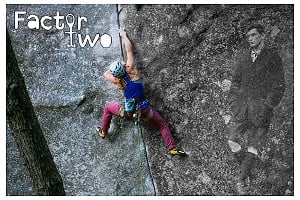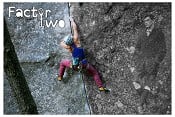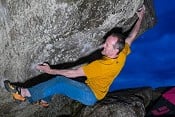
Hi,
I'm a student at the University of Cumbria conducting research for my dissertation. The topic is perceived risk across different rock climbing disciplines.
My questionnaire is linked below, included is an information sheet that gives more detail into my research and how your answers will be used.
I would be grateful if you could take 5 minutes to complete this questionnaire. 'Posted with permission of UKClimbing'
https://cumbria.onlinesurveys.ac.uk/risk-perception
Thank you for your time,
Richard Smith
Might be harder to quantify I suppose - but the survey seems to pigeon hole climbers into a few selective disciplines. The absence of ice, winter, alpine and mountaineering are notable.
> The topic is perceived risk across different climbing disciplines.
It's actually only about rock climbing disciplines so no point in anyone who mainly winter climbs etc trying to complete it.
This is clear on the survey but not in the post above.
As already said, you omit winter & alpine climbing, and although you have bouldering, you don't have a category for soloing - I assume 'trad' means roped climbing. Also surprised you don't split 'trad', at least in single /multi-pitch, but also lowland/mountain/seacliff - at least for me, there's a big difference (at least in perception) in climbing on a small roadside crag compared to a seacliff accessible only by abseil or a remote Scottish mountain crag
Done, however the last question makes no sense at all!
Useless.
I did have an open mind but this survey maintains the low standard we are now used to here.
I'm a classic British all-round climber who has done everything including sport, trad, UK winter, ice, alpine, big walls and greater ranges but thanks to your poorly worded survey I'm just an indoor boulderer.
(I spend probably three times longer climbing and mountaineering outdoors as I do indoors but my outdoor trips are full days split between multiple disciplines whereas my climbing wall sessions are short but more numerous in total.)
There is scope for some superb work to be done on risk perception in climbing and mountaineering however this survey completely misses what are potentially key issues.
Most UK climbers over-estimate the absolute risk of rock climbing, both indoors as well as sport and trad compared to other activities and generic risks. They tend to have a good a idea of which climbing disciplines are more risky than others but have less idea of by how much.
When it comes to Winter climbing, Alpine climbing and Greater Ranges Mountaineering, most individuals (both climbers and non-climbers) again have an accurate perception that 8000m peaks are more dangerous than the Alps which is in turn more dangerous than Scotland in Winter. However they tend to greatly under-estimate how rapidly the risk increases.
Asking climbers to rank relative risk between a very limited set of objectively low and very low risk disciplines seems especially pointless.
Pretty harsh
he takes 4 easily defined, popular climbing styles and asks how we perceive the risk for each of them, he cuts it into age and gender, it seemed clear defined and limited.
If you want to further chop climbing into multi, single, alpine and winter you need another survey, it will reduce your sample size.
Better than most, I though
Done
I do love the contrast between the Ex-Engineer's lengthy, petulant, self indulgent rant and the post immediately following that merely reads 'done'.
Done, I thought it was quite a reasonable survey (especially when compared with others that have been advertised on here).
Completed. As mentioned certainly not the worst questionnaire. As a point of interest do supervisors suggest students do a trial run on a few carefully selected people from the target audience and modify forms accordingly before sending them out?
When I was at work I remember many forms, eg safety assessments, sent out that had ambivalent questions and did not "behave" correctly on different PCs (no latter problem in this case).
for me the worst offenders in risk perception vs objective risks are
- Via Ferrata (much more dangerous than percieved)
- Snowshoing (massive amounts of people wandering abouts in the alps without any avalanche gear or knowledge)
Sportclimbing is the other way around; the percieved risk is much higher than the objective risk, which is great for training your exposure tolerance for mountaineering (where stuff tends to get very serious if you loose your cool).
In my perception there are too many multi options, all relevant to a question demanding a single answer. For example in winter I climb exclusively indoors, but in summer it's outdoors, both sport and traditional, as well as indoor walls on bad weather days.
You will not get a truly accurate perspective as I for one would be classed as an indoor climber based solely on climbing wall visits. Nothing could be further from the truth.
In my perception there are too many multi options all relevant to a question demanding a single answer. For example in winter I climb exclusively indoors but in summer it's outdoors, both sport and traditional, as well as indoor walls on bad weather days. You will not get a truly accurate perspective as I for one would be classed as an indoor climber based solely on climbing wall visits. Nothing could be further from the truth.
But he,s right!
Done. Would be better to explore risk and motivation in one aspect, rather than 4 vastly different disciplines. Indoor bouldering and outdoor trad, is like comparing crown green bowling and cave diving.
Thank you very much for all of your comments so far. All of them will help me to build a better dissertation thesis.
I apologise for the confusion over the disciplines. The decision to make it solely about rock climbing and the four climbing disciplines was made as they all have different levels of risk exposure. Therefore providing a structure to base the climbers' perception of risk off.
Thanks again for taking the time to fill out my questionnaire,
Richard Smith
I think it was quite good, within its own context. Bar the last question, which makes an interesting assumption
I would have completed it if it had allowed me to express what I thought as opposed to giving me a limited choice of answers.
Hi Richard. Having read the comments above before completing the survey I cheated by claiming my most frequent visits were to outdoor trad venues whereas, as for most respondents I expect, they are to indoor walls. But I am a trad climber - for me the walls are just for training!
This is not a bad survey as student surveys go - and we get many of them on here - but I wonder if you took the opportunity to trial it on a few climbers (of different ages) to iron out ambiguities before publishing?
Sorry if this sounds patronising, but to those posters who tend to be over-critical of these surveys let's not forget that their prime purpose is to assist Richard et al up their own undergraduate learning curves, not to provide results that stand up to scientific scrutiny.
Martin (former University of Cumbria student - Charlotte Mason College 1976)
> Sorry if this sounds patronising, but to those posters who tend to be over-critical of these surveys let's not forget that their prime purpose is to assist Richard et al up their own undergraduate learning curves, not to provide results that stand up to scientific scrutiny.
Agree most of these surveys are a part of the learning process rather than to produce 'publishable research' but a quick trial to make sure the survey works & can deliver meaningful data will make the analysis & writing up much easier. I occasionally have to prepare short questionnaires for work & would never circulate one without getting a couple (at least) of colleagues to test it first.
Done.
Many questions were difficult to answer accurately, though. The last question seemed particularly clumsy: "pinnacle of risk" in terms of how it feels, or how it is rationally assessed? And why set that up as an "either or" choice with the strangely specific idea of using indoor leader falls as practice for outdoor trad? Why not equally for outdoor sport, or indoor leading?
Done. A reasonable survey I thought. One comment I have is that risk is a combination of the likelihood and the consequence of an event. This could be used particularly useful when comparing falls in sport vs trad climbing.
Ps. Google risk matrix if you haven't already looked at one of these.
Thank you for the suggestion on google risk matrix and the comment above, great help.
> Done. A reasonable survey I thought. One comment I have is that risk is a combination of the likelihood and the consequence of an event.
And that's where it gets really complicated, because neither likelihood nor consequence are fixed, and what you really have for trad is compound risk , e.g. you need to fail and fall, gear to rip, a little bit too much rope out, ground/ledge too close etc, but you land on your mate/collapsing grass ledge or hit nothing.
Nevertheless, it's a valid comparison for sport and trad, in that you could say that falling is mainly safe for sport but that the risk is indeterminate for trad. Strictly speaking, sport isn't that straightforward, with compound risk applying in spades for the second and third clip, with risk arguably decreasing the higher you climb. The converse is true with bouldering, as risk increases as height is gained.
For what it's worth, I wince when I see someone spotting a leader up to the first clip at an indoor wall with a nice rubber floor. I just see ample opportunity for the belayer to tangle their fingers in the leader's gear loops and break them, their fingers.
You need a big mathematical model, someone with a PhD in a relevant subject, a lot of time, and you still won't have an answer, because a goat will knock a rock off the edge and muller the belayer.........
What evidence do you have that indoor climbers overestimate risk?. My impression has always been there is a wide range of risk perception indoors but typically lower than the range outdoors (especially bouldering).
Nice rant! Please quote some existing studies to back up your assertions! We will just have to assume it is all your own opinion!
Of course it´s a rant! We don´t know how many climbers there are, how often they do the various activities and how often they have accidents so we have no idea of the real risk let alone how these unknown climbers the perceive the risk. Any assertion that the climbers perceive risk differently to the real risk is pure guesswork.
Whether it is all of any importance is also questionable, whether climber A thinks what climber B does is riskier is irrelevant even if they were able to show it was.
That was very good. Completed.
Hence the purpose of statistical studies and significant tests! Course you will always have opinionated outliers skewing your distribution!
Thanks again for filling out my questionnaire.
It is still live so please continue to complete and give feedback, it all helps.
Thank you for your time,
Richard Smith
This questionnaire is still open for another week, 15th March is the ending date.
I would be very grateful if you could take 5 minutes to complete it.
Thanks,
Richard
Done.
In asking about risk perception changing with age, could have been more personal perhaps.....
Done, but it's not without faults








